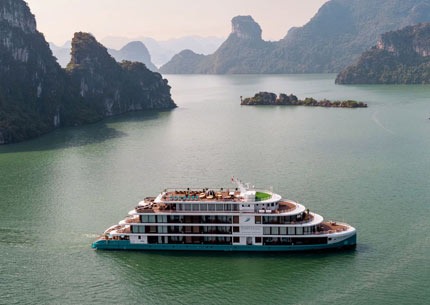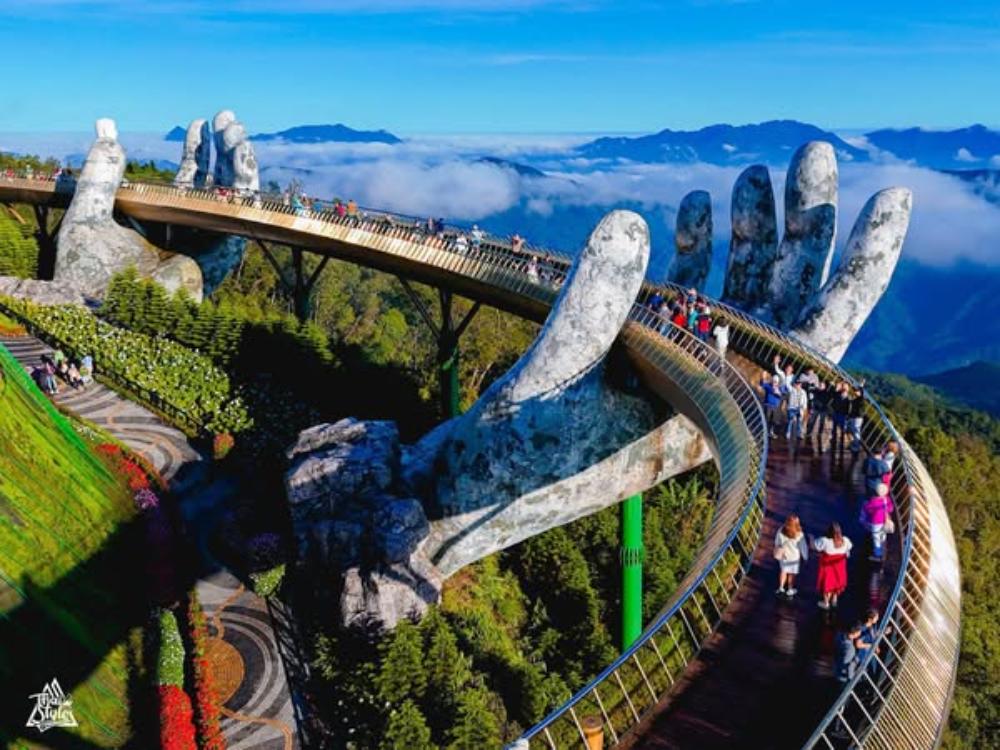Da Nang Typhoon Season: 15 Essential Safety Tips for Travelers
Vietnam’s coastal city of Da Nang blends stunning beaches with vibrant urban experiences, making it a top destination for travelers. However, understanding its weather patterns, particularly the typhoon season, is crucial for a successful trip. This comprehensive guide equips you with everything you need to know about navigating Da Nang during storm season in 2025-2027, ensuring your journey remains both safe and memorable.
When Exactly Is Da Nang’s Typhoon Season?
The typhoon season in Da Nang typically runs from late August through mid-November, with peak activity occurring during September and October. This coastal region faces the East Sea (South China Sea), making it particularly vulnerable to tropical storms that develop in the Western Pacific.
According to the latest projections from the Vietnam Meteorological and Hydrological Administration, the 2025 season may see between 9-11 tropical storms forming in the Western Pacific, with approximately 3-5 potentially affecting Central Vietnam, including Da Nang. This represents a slight increase from previous years, likely influenced by changing climate patterns.
For travelers planning visits in 2026-2027, meteorologists predict similar patterns with potentially intensifying storm strength due to warming ocean temperatures. The typhoon season’s timing, however, is expected to remain consistent.

Historical Typhoon Data for Da Nang (2020-2024)
Recent years have provided valuable data on storm patterns in Central Vietnam:
| Year | Number of Storms Affecting Da Nang | Most Severe Month | Average Rainfall During Peak Season
|
|---|---|---|---|
| 2020 | 4 | October | 387mm |
| 2021 | 2 | September | 342mm |
| 2022 | 3 | October, | 410mm |
| 2023 | 3 | September, | 375mm |
| 2024 | 4 (projected) | October. | 390mm (projected) |
This historical context helps travelers understand what to expect during the 2025-2027 seasons.
Monthly Weather Breakdown: Plan Your Visit Strategically
Understanding month-by-month conditions will help you decide when to visit Da Nang, even during typhoon season.
August: Early Warning Signs
- Temperature Range: 27°C–34°C (81°F–93°F)
- Average Rainfall: 150-200mm
- Humidity: 75-85%
- Sea Conditions: Generally calm with occasional swells
- Tourist Density: Moderate to high
- Event Highlight: Da Nang International Fireworks Festival (typically early August)
August offers a strategic window for visitors wanting to experience Da Nang’s coastal beauty before the peak storm season. Days are predominantly sunny with occasional afternoon showers that rarely last more than an hour or two.
September: Increasing Storm Activity
- Temperature Range: 25°C–32°C (77°F–90°F)
- Average Rainfall: 250-300mm
- Humidity: 80-90%
- Sea Conditions: Moderate swells, occasional beach closures
- Tourist Density: Moderate, declining mid-month
- Event Highlight: Mid-Autumn Festival celebrations
While not every day experiences storms, the chance of encountering multiple consecutive rainy days increases substantially, particularly in the latter half of the month.
October: Peak Typhoon Period
- Temperature Range: 24°C–30°C (75°F–86°F)
- Average Rainfall: 400-450mm
- Humidity: 85-95%
- Sea Conditions: Rough seas, frequent beach closures
- Tourist Density: Low
The month often experiences 2-3 significant weather events that may require temporary business closures and transportation adjustments. However, these events are typically forecasted 3-5 days in advance, allowing for itinerary adjustments.
November: Gradual Improvement
November marks the transition out of typhoon season:
- Temperature Range: 22°C–29°C (72°F–84°F)
- Average Rainfall: 200-250mm, declining toward month’s end
- Humidity: 75-85%
- Sea Conditions: Improving, with occasional moderate swells
- Tourist Density: Beginning to increase
- Event Highlight: Da Nang Food Festival (varies by year)
By mid-November, storm risk decreases significantly, though residual rainfall continues. The latter half of November often provides pleasant conditions with cooler temperatures and diminishing rainfall, making it an attractive time for visitors who want to avoid both peak typhoon season and high-season crowds.
15 Essential Safety Tips for Traveling During Da Nang’s Typhoon Season
Navigating Da Nang during storm season requires preparation. These tips will help ensure your safety while maximizing your experience:
1. Invest in Comprehensive Travel Insurance
Standard travel insurance often excludes or limits coverage for weather events. For 2025-2027 travel to Da Nang during typhoon season, select a policy that explicitly covers:
- Weather-related cancellations and delays
- Emergency evacuation if necessary
- Medical expenses related to storm incidents
- Accommodation expenses during forced extended stays
Top recommended providers for Vietnam typhoon coverage include World Nomads, Allianz, and SafetyWing, which offer specific natural disaster provisions.
2. Book Accommodations Strategically
Your choice of accommodation can significantly impact your safety during a storm:
- Choose hotels at least 500 meters inland from the beach during peak typhoon months
- Select properties with backup generators, as power outages during storms can last 12-24 hours
- Prioritize newer buildings (constructed after 2010) that adhere to updated safety codes
- Consider high-rise hotels (floors 4 and above) to avoid ground-floor flooding
Many international hotel chains in Da Nang, including Hyatt Regency, Hilton, and InterContinental, have robust emergency protocols specifically designed for typhoon scenarios.
3. Master These Vital Vietnamese Phrases
Communication during emergencies is crucial. Memorize these essential phrases:
- “Bão đến khi nào?” (When will the typhoon arrive?)
- “Đâu là nơi an toàn?” (Where is a safe place?)
- “Tôi cần giúp đỡ” (I need help)
- “Nơi sơ tán ở đâu?” (Where is the evacuation center?)
- “Có nguy hiểm không?” (Is it dangerous?)
Having these phrases accessible on your phone (even without internet) can prove invaluable during urgent situations.
4. Download These Essential Weather Applications
Stay informed with real-time weather updates:
- Windy.com – Provides detailed wind and precipitation forecasts with visual mapping
- VnAlert – Vietnam’s official disaster alert system with English language option
- AccuWeather – Offers hour-by-hour precipitation forecasts
- What3words – Location-sharing app that works without street addresses (useful during evacuations)
Configure these apps to send push notifications for severe weather alerts specific to Da Nang.
5. Pack These Typhoon-Ready Essentials
Your packing list should include:
- Waterproof phone case and dry bag for important documents
- Portable battery pack (minimum 20,000mAh) for extended power outages
- Lightweight rain poncho (superior to umbrellas in strong winds)
- Quick-dry clothing (synthetic materials like polyester or nylon)
- Waterproof footwear that drains easily
- First aid kit with basic medications and bandages
- Flashlight or headlamp with extra batteries
These items ensure you remain prepared without significantly increasing your luggage weight.
6. Create a Flexible Itinerary
Design your Da Nang experience with weather contingencies in mind:
- Plan indoor activities for days with forecasted heavy rain
- Schedule beach days early in your trip, allowing for postponement if needed
- Book tours with generous cancellation policies (look for “free cancellation up to 24 hours before”)
- Identify alternate activities for each planned excursion
A flexible approach allows you to adapt quickly to changing weather conditions without sacrificing your overall experience.
7. Establish an Emergency Contact Protocol
Before your trip:
- Share your detailed itinerary with family or friends not traveling with you
- Register with your country’s embassy in Vietnam through their traveler program
- Establish check-in intervals with contacts at home
- Note the location of your country’s consulate in Da Nang or nearest city
Having a communication plan ensures someone knows your whereabouts during potential emergencies.
8. Understand Storm Warning Categories
Vietnamese authorities use a five-level tropical cyclone warning system:
- Level 1: Wind speeds of 39-61 km/h (24-38 mph) – Exercise caution
- Level2: Wind speeds of 62-88 km/h (39-54 mph) – Secure loose objects
- Level 3: Wind speeds of 89-117 km/h (55-73 mph) – Stay indoors
- Level4: Wind speeds of 118-133 km/h (74-83 mph) – Potential evacuation
- Level 5: Wind speeds exceeding 134 km/h (83 mph) – Mandatory evacuation
Knowing these levels helps you interpret local warnings accurately and respond appropriately.
9. Learn to Identify Safe Shelter Options
If caught away from your accommodation during a severe storm:
- Shopping malls like Vincom Plaza Da Nang offer secure shelter
- Government buildings are constructed to withstand severe weather
- Hospitals maintain emergency power and supplies
- Designated storm shelters are established in every district
The Da Nang Department of Tourism maintains an updated list of official shelter locations, accessible through their website.
10. Recognize Post-Storm Hazards
After a typhoon passes:
- Avoid standing water, which may contain contaminants or conceal hazards
- Be cautious of damaged buildings and falling debris
- Don’t touch downed electrical wires or poles
- Use bottled water until authorities confirm tap water safety
- Be alert for transportation disruptions that may last 24-72 hours after a storm
Post-storm conditions often pose more risks than the storm itself, particularly regarding water safety and infrastructure damage.
11. Keep Emergency Funds Accessible
Financial preparation is essential:
- Carry cash in Vietnamese Dong (VND), as ATMs may be unavailable during power outages
- Have at least $200 USD equivalent per person for emergency situations
- Keep funds in multiple locations (hotel safe, money belt, separate bag)
- Have access to emergency credit with sufficient available balance
Cash remains the most reliable payment method during and immediately after weather emergencies in Vietnam.
12. Know Medical Emergency Procedures
In case of injury or illness during severe weather:
- Vinmec Da Nang International Hospital maintains 24/7 emergency services with English-speaking staff
- Family Hospital Da Nang offers comprehensive care and accepts international insurance
- Save the emergency number 115 for ambulance services
- Download the “Vietnam Emergency” app for direct connection to medical services
These facilities have emergency generators and continue operations even during severe weather events.
13. Monitor Beach and Water Safety Flags
Da Nang’s beaches use an international flag warning system:
- Green: Safe for swimming
- Yellow: Caution advised, moderate conditions
- Red: Dangerous conditions, swimming prohibited
- Double Red: Beach closed, extreme danger
During typhoon season, red and double red flags are common. Never ignore these warnings, as Da Nang’s currents become exceptionally dangerous during storm systems.
14. Prepare for Transportation Disruptions
Typhoons significantly impact transportation networks:
- Flights: Da Nang International Airport may suspend operations 12-24 hours before and after severe storms
- Trains: The North-South railway service often experiences delays of 6-24 hours
- Buses: Long-distance services to Hoi An, Hue, and other destinations may be suspended
- Rideshares: Grab and other services typically reduce or suspend operations during severe weather
Building buffer days into your itinerary, particularly before international departures, helps accommodate these disruptions.
15. Leverage Hotel Concierge Services
Hotel staff provide valuable assistance during weather emergencies:
- Request daily weather briefings from front desk staff
- Ask about hotel emergency protocols upon check-in
- Utilize concierge services to reorganize activities around weather patterns
- Inquire about hotel provisions during extended storm periods
Most international and larger Vietnamese hotel chains in Da Nang have comprehensive guest safety protocols for typhoon scenarios.
Alternative Activities During Stormy Weather in Da Nang
When outdoor plans become impossible, Da Nang offers numerous engaging indoor alternatives:
Cultural Immersion Opportunities
- Da Nang Museum of Cham Sculpture: Housing over 300 artifacts from the Champa civilization, this 2,500-square-meter museum provides hours of fascinating exploration regardless of weather conditions.
- Fine Arts Museum: Located in the city center, this 1,000-square-meter facility showcases both traditional and contemporary Vietnamese art.
- Museum of Da Nang: Learn about the city’s rich history through interactive exhibits spanning 3,000 years of development.
Culinary Adventures
- Cooking Classes: Several establishments offer hands-on Vietnamese cooking experiences, including Thuan Tinh Cooking School and Red Bridge Cooking School, both providing market tours and instruction in preparing regional specialties.
- Food Tours: Companies like Da Nang Food Tour offer covered tasting experiences that continue rain or shine, introducing visitors to authentic local cuisine.
- Coffee Culture: Experience Vietnam’s unique coffee heritage at establishments like Cong Caphe and The Workshop, where traditional egg coffee and other specialties are served in atmospheric settings.
Relaxation and Wellness
During typhoon season, Da Nang’s world-class spas offer perfect shelter from the elements:
- Nang Spa: Located in the city center, offering traditional Vietnamese treatments including herbal compression and cupping therapy.
- Danang Golden Bay Hotel Spa: Features a comprehensive menu of treatments in a luxurious 1,200-square-meter facility.
- Fusion Maia Da Nang: All-inclusive spa resort where unlimited treatments are included in your stay.
Shopping and Entertainment
- Vincom Plaza Da Nang: This 50,000-square-meter shopping complex houses international brands, a cinema, food court, and entertainment options for all ages.
- Han Market: This covered market spans 28,000 square meters and offers everything from local handicrafts to clothing and food souvenirs.
- Helio Center: An indoor entertainment complex featuring bowling, arcade games, and various dining options.
Where to Stay: Typhoon-Safe Accommodations in Da Nang
Choosing the right accommodation significantly impacts your safety during typhoon season. These properties are known for their excellent storm preparedness:
Luxury Options with Superior Storm Readiness
- Hyatt Regency Da Nang: Built to international safety standards with backup generators, storm shutters, and an elevation that minimizes flooding risk. The property maintains a 3-day food and water supply for guests during emergencies.
- InterContinental Danang Sun Peninsula Resort: Despite its hillside location, this resort features reinforced construction and comprehensive evacuation procedures. Its elevation provides natural protection from flooding.
- Hilton Da Nang: Located in the city center away from flood-prone coastal areas, with 24/7 backup power systems and dedicated safety staff.
Mid-Range Choices with Solid Safety Features
- Novotel Danang Premier Han River: Situated in a modern high-rise with flood-resistant design elements and comprehensive emergency protocols.
- Belle Maison Parosand Danang: Located 600 meters from the beach with reinforced construction and reliable backup systems.
- Vanda Hotel: In the city center with good elevation above potential flood levels and comprehensive guest safety procedures.
Budget-Friendly Yet Storm-Safe Options
- Funtastic Danang Hostel: Located in the city center away from flood zones with concrete construction and emergency planning.
- Danang Backpackers Hostel: Situated in a newer building with good elevation and staff trained in emergency procedures.
- Barny Danang Hostel: Simple but secure accommodations with flood-resistant location and backup power.
Planning a Trip to Halong Bay After Da Nang
Many travelers combine Da Nang with other Vietnamese destinations, particularly Halong Bay in the north. While Central Vietnam experiences its typhoon season, northern Vietnam may offer more stable weather conditions, making it an excellent addition to your itinerary.
Coordinating Weather Patterns Between Regions
Halong Bay’s storm season doesn’t perfectly align with Da Nang’s:
| Month | Da Nang Weather | Halong Bay Weather
|
|---|---|---|
| August | Early typhoon season | End of summer, occasional storms |
| September | Peak typhoon activity | Generally favorable with moderate rain |
| October | Highest typhoon risk | Pleasant, cooler temperatures |
| November | Late typhoon season | Clear, cooler conditions |
This complementary pattern makes a north-to-south or south-to-north itinerary particularly strategic during Vietnam’s various monsoon and typhoon seasons.
Luxury Cruise Options in Halong Bay
For travelers seeking premium experiences after weathering Da Nang’s storms, consider these outstanding cruise options:
- 2-Day Halong & Lan Ha Bay 5-Star Cruise: This luxurious overnight experience takes you through the breathtaking limestone karsts of both Halong and Lan Ha Bays. The cruise includes gourmet dining, spacious 28-square-meter cabins with private balconies, and activities like kayaking and cave exploration.
- 3-Day 5-Star Lan Ha Bay and Halong Bay Cruise: For a more immersive experience, this extended cruise provides additional time to explore the region’s hidden gems. With three days on the water, you’ll enjoy premium amenities, exclusive access to secluded beaches, and a comprehensive cultural program including tai chi classes and Vietnamese cooking demonstrations.
These cruises operate year-round, with October through December offering some of the most pleasant weather conditions in northern Vietnam – perfectly complementing a post-typhoon season visit to Da Nang.
Frequently Asked Questions About Da Nang’s Typhoon Season
Is it completely unsafe to visit Da Nang during typhoon season?
No, visiting Da Nang during typhoon season isn’t inherently unsafe. Most days, even during peak typhoon months, don’t experience severe weather. Major storms typically provide 3-5 days of advance warning, allowing for preparations. The city’s infrastructure has improved significantly since 2017, with better drainage systems and building codes designed to withstand tropical storms.
How far in advance can typhoons be predicted?
Modern meteorological technology allows for increasingly accurate predictions. General storm formation can be detected 7-10 days in advance, while precise landfall predictions become reliable 3-5 days before impact. The Vietnam Meteorological and Hydrological Administration issues regular updates during typhoon season, with English translations available through various weather apps.
Are there parts of Da Nang less affected by typhoons?
Yes. Western districts farther from the coast, such as Hoa Vang District, typically experience less flooding. Areas with higher elevation, including properties near Son Tra Peninsula and Marble Mountains, also fare better during heavy rainfall. However, all areas remain subject to wind damage and potential power outages during direct typhoon impacts.
What happens if I’m scheduled to fly during a typhoon?
Da Nang International Airport typically suspends operations when wind speeds exceed 65 km/h (40 mph) or when visibility drops below minimum safety thresholds. Most airlines serving Da Nang offer weather-related rebooking without penalty during officially declared weather emergencies. Carriers like Vietnam Airlines, Bamboo Airways, and VietJet maintain dedicated customer service lines for weather-related disruptions.
How quickly does Da Nang recover after a typhoon?
Da Nang has developed efficient post-storm recovery systems. Major roads are typically cleared within 12-24 hours after a storm passes. Power restoration to most areas occurs within 24-48 hours, with tourist districts receiving priority. Beaches usually require 2-3 days to be declared safe after significant storms due to water quality testing and debris removal.
Can I still visit beaches during typhoon season?
Yes, but with caution. Even during typhoon season, Da Nang experiences many days with suitable beach conditions. Always observe flag warnings and lifeguard instructions. Morning hours typically offer the best beach conditions during storm season, as afternoon thunderstorms are more common. My Khe Beach and Non Nuoc Beach both employ full-time lifeguards trained in international safety standards.
Conclusion: Embracing Da Nang’s Weather Realities
Da Nang’s typhoon season presents challenges but doesn’t diminish the city’s appeal as a destination. With proper preparation, flexible planning, and the safety tips outlined in this guide, travelers can enjoy memorable experiences in this vibrant coastal city even during 2025-2027 storm seasons.
The key to a successful visit lies in preparation rather than avoidance. By understanding weather patterns, establishing safety protocols, and maintaining flexibility, you can discover Da Nang’s rich culture, cuisine, and natural beauty regardless of when you visit.
Whether you’re drawn to Da Nang’s pristine beaches, vibrant city life, or convenient access to UNESCO sites like Hoi An and Hue, this comprehensive guide ensures you’re equipped to navigate any weather challenges while maximizing your Vietnamese adventure.
After experiencing Da Nang, consider extending your Vietnamese journey to include the spectacular limestone karsts of Halong Bay, where you can continue your exploration of Vietnam’s diverse landscapes and cultures in a different climate zone.
- Hotline | WhatsApp: +84.978.358.422
- Phone | WhatsApp: +84.962.261.687
- Email: halongbayluxcruises@gmail.com
- vietnammarveltravel@gmail.com














